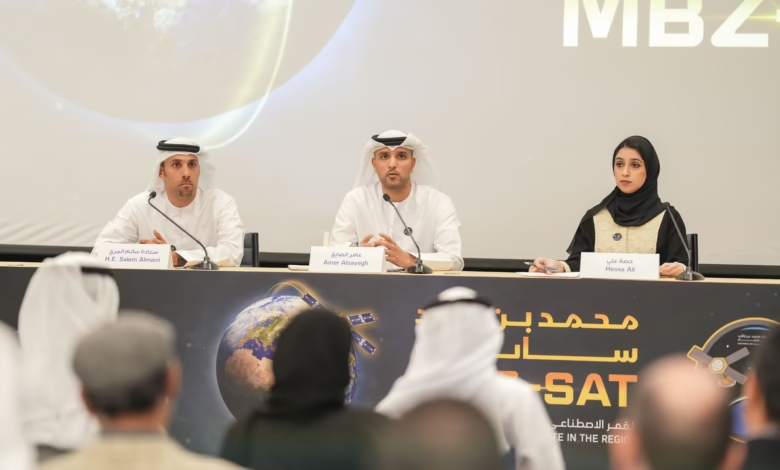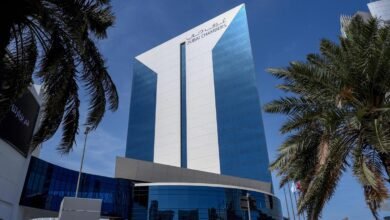
Breaking: UAE’s MBZ-SAT Enters Final Launch Preparation Phase
UAE’s most advanced Earth observation satellite, the MBZ-SAT, features remarkable capabilities that capture images with twice the precision of previous models and process them within two hours. Named after President His Highness Sheik Mohamed bin Zayed Al Nahyan, it marks a significant milestone in the country’s space program. Local UAE companies developed nearly 90% of its mechanical structures and key electronic modules.
SpaceX’s Falcon 9 rocket will launch this one-ton satellite from Vandenberg Space Force Base in California in January 2025, demonstrating UAE’s growing aerospace expertise. The project brought together more than 200 engineers, researchers, and experts who presented the shared spirit driving the nation’s space program. The satellite will launch alongside the student-built HCT-SAT 1, a compact 10cm CubeSat. MBRSC mentored over 50 Higher Colleges of Technology students to develop this CubeSat.
Technical Specifications and Capabilities
The MBZ-SAT measures three meters by five meters and weighs 700 kilograms. Its automated system, which continuously acquires and processes images, marks a significant step forward in satellite technology.
The satellite’s capabilities exceed expectations:
- Images twice as sharp as earlier models
- Produces ten times more images
- Data transmission speed is three times faster than current rates
- Delivers processed images in less than two hours
The satellite is equipped with innovative propulsion technology and navigation systems. Its electric propulsion and one-meter-accurate navigation system set new standards. The automated image scheduling system works 24/7 to deliver high-quality commercial satellite imagery consistently.
UAE companies played a crucial role in MBZ-SAT’s development. They manufactured almost 90% of its mechanical structures and essential electronic modules. The satellite’s aluminum components made history as the first space-grade aluminum produced using solar power.
Launch Preparation Milestones
The UAE’s space program has reached a pivotal moment as MBZ-SAT nears its launch. The satellite completed its environmental tests at the Korea Aerospace Research Institute (KARI).
Tariq AlNasser, the Environmental Test Manager, oversaw a two-month testing phase that covered four vital evaluations:
- Thermal Vacuum (TVAC) testing – simulating extreme space temperatures
- Vibration testing – assessing structural integrity
- Acoustic testing – replicating launch sound pressures
- Mass Properties testing – measuring the precise mass distribution
The team assembled the satellite in the UAE and placed it in a specialized container with monitoring systems to ensure its safe transport. The satellite then traveled to South Korea, where MBRSC’s logistical team collaborated with KARI for rigorous environmental testing.
The satellite moved to Vandenberg Space Force Base in California after completing its tests at KARI. The MBRSC team monitors and verifies all systems to ensure the satellite performs optimally during launch.
This extensive testing sequence shows MBRSC’s steadfast dedication to ensuring the satellite can withstand space’s demanding conditions. The UAE’s ambitious space program achieved another milestone as these preparation phases concluded successfully.
Mission Control and Operations
The MBRSC headquarters in Dubai houses the Mission Control Center that manages MBZ-SAT operations. A dedicated ground station team works 24/7 to monitor the satellite, analyze data, and recommend performance improvements.
The satellite features a cutting-edge automated image processing system with remarkable capabilities:
- Users receive processed images within two hours of their request
- Data captured reaches users quickly
- The production output is 10 times higher than current systems
The ground station’s resilient infrastructure includes specialized facilities for detailed mission management. At the center, the S-band receiving stations and the Image Receiving and Processing Station (IRPS) handle X-band data reception.
Businesses and government organizations can access high-resolution imaging services online. The satellite supports map preparation, environmental monitoring, and disaster management applications.
The Mission Control Center handles every aspect of the space mission, including configuring resources and scheduling space and ground elements. Advanced systems at the center effectively process, distribute, and archive satellite imagery for various applications.
MBZ-SAT represents the most critical milestone in UAE’s space sector, showcasing its technological advancement and manufacturing capabilities. The satellite project demonstrates excellence in space exploration through testing phases and careful preparation. Sophisticated mission control and automated processing systems make this satellite a powerful tool for Earth observation and data collection. More than 200 engineers and researchers have contributed to this groundbreaking project, marking a defining moment in UAE’s trip toward global leadership in space technology. MBZ-SAT’s development and upcoming launch set new benchmarks for future space initiatives and deepened UAE’s position in the international aerospace community.






